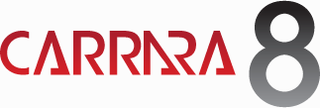
Rendering or image synthesis is the process of generating a photorealistic or non-photorealistic image from a 2D or 3D model by means of a computer program. The resulting image is referred to as the render. Multiple models can be defined in a scene file containing objects in a strictly defined language or data structure. The scene file contains geometry, viewpoint, texture, lighting, and shading information describing the virtual scene. The data contained in the scene file is then passed to a rendering program to be processed and output to a digital image or raster graphics image file. The term "rendering" is analogous to the concept of an artist's impression of a scene. The term "rendering" is also used to describe the process of calculating effects in a video editing program to produce the final video output.

Vector graphics is a form of computer graphics in which visual images are created directly from geometric shapes defined on a Cartesian plane, such as points, lines, Curves and polygons. The associated mechanisms may include vector display and printing hardware, vector data models and file formats, as well as the software based on these data models. Vector graphics is an alternative to raster or bitmap graphics, with each having advantages and disadvantages in specific situations.

Poser is a 3D computer graphics program distributed by Bondware. Poser is optimized for the 3D modeling of human figures. By enabling beginners to produce basic animations and digital images, along with the extensive availability of third-party digital 3D models, it has attained much popularity.
Infini-D was a 3D computer graphics program developed by Specular International. It was continued by MetaCreations when Specular merged with them, developing up to version 4.5, then combined with Ray Dream Studio to create Carrara. Soon after, Metacreations divested itself of all products other than MetaStream, including Carrara, which was sold to Eovia, who then sold it to the current developer, DAZ, upon Eovia's breaking up.

Cairo is an open-source graphics library that provides a vector graphics-based, device-independent API for software developers. It provides primitives for two-dimensional drawing across a number of different back ends. Cairo uses hardware acceleration when available.
COLLADA is an interchange file format for interactive 3D applications. It is managed by the nonprofit technology consortium, the Khronos Group, and has been adopted by ISO as a publicly available specification, ISO/PAS 17506.
A number of vector graphics editors exist for various platforms. Potential users of these editors will make a comparison of vector graphics editors based on factors such as the availability for the user's platform, the software license, the feature set, the merits of the user interface (UI) and the focus of the program. Some programs are more suitable for artistic work while others are better for technical drawings. Another important factor is the application's support of various vector and bitmap image formats for import and export.

Daz Studio is a free media design software developed by Daz 3D. Daz Studio is a 3D scene creation and rendering application used to produce images as well as video. Renders can be done by leveraging either the 3Delight render engine, or the Iray render engine, both of which ship for free along with Daz Studio, or with a variety of purchasable add-on render engine plugins for Daz Studio from various vendors and companies.

Graphic art software is a subclass of application software used for graphic design, multimedia development, stylized image development, technical illustration, general image editing, or simply to access graphic files. Art software uses either raster or vector graphic reading and editing methods to create, edit, and view art.

MetaCreations was a computer software company that was best known for its graphics applications, notably Ray Dream Studio/Infini D, Fractal Design Painter, Bryce, and Kai's Power Tools.

Carrara is a full-featured 3D computer graphics application featuring figure posing and editing, as well as nature modeling, in addition to traditional modeling, animation, texturing and rendering. The software is also capable of dynamic hair and fur simulations, particle effects, soft body and rigid body dynamics. Carrara is now owned and developed by Daz 3D. Carrara is compatible with Poser and Daz Studio formats of 3D figures and props. It is further supported by a number of 3rd party plug-ins and add-ons.

3D computer graphics, or “3D graphics,” sometimes called CGI, 3D-CGI or three-dimensional computer graphics are graphics that use a three-dimensional representation of geometric data that is stored in the computer for the purposes of performing calculations and rendering digital images, usually 2D images but sometimes 3D images. The resulting images may be stored for viewing later or displayed in real time.

Daz Productions, Inc. is a 3D-content and software company specializing in providing rigged 3D human models, associated accessory content, and software to the hobbyist as well as the prosumer market.

Hexagon is a subdivision-type 3D modeler owned by Daz 3D. It was originally developed and published by Eovia and was acquired shortly before the release of version 2.0 by Daz 3D in 2006. The software drew heavily on Eovia's other modeler, Amapi, though it omitted the NURBs and precision measuring tools. The focus is subdivision modeling, but it includes spline tools and surface tools. Because of the two omissions, it is not as well suited to product design as Amapi, but is aimed more at illustrative and character modeling, with an eye to making it accessible for those new to working in 3D.
Ray Dream Studio was a low-end 3D modeling software application. Initially developed by Ray Dream, Inc. in 1989-1991 for the Macintosh, it was acquired and upgraded over the course of mergers with Fractal Design and MetaCreations. Ray Dream was less expensive than most other offerings, renowned for its ease of use, and boasted an impressive feature set including a sophisticated shader editor. Other software programs from the same developers, such as Fractal Design Painter 3D, were often introduced in basic form to the suite. A moderately limited version lacking animation capability was sold for $99 as Ray Dream Designer, and quickly became a mass-market favorite.

Computer graphics deals with generating images with the aid of computers. Today, computer graphics is a core technology in digital photography, film, video games, cell phone and computer displays, and many specialized applications. A great deal of specialized hardware and software has been developed, with the displays of most devices being driven by computer graphics hardware. It is a vast and recently developed area of computer science. The phrase was coined in 1960 by computer graphics researchers Verne Hudson and William Fetter of Boeing. It is often abbreviated as CG, or typically in the context of film as computer generated imagery (CGI). The non-artistic aspects of computer graphics are the subject of computer science research.
Shade 3D is a 3D modeling, rendering, animation, 3D printing computer program developed by e frontier Japan and published by Mirye Software. In October 2013, Shade 3D development team formed a new company called Shade3D Co.,Ltd., and continue to develop and market the program. After terminating the sales agreement with e frontier Japan and Mirye Software by the end of December 2014, Shade3D company is now developing and marketing Shade 3D products in Japan and worldwide exclusively.

In 3D computer graphics, 3D modeling is the process of developing a mathematical coordinate-based representation of any surface of an object in three dimensions via specialized software by manipulating edges, vertices, and polygons in a simulated 3D space.
Amapi was a 3D modeler created by Yonowat S.A. that incorporates both polygonal modeling and NURBS surface modeling. Amapi was used to create models for industrial design, architecture, interior design, furniture, exhibit design, packaging, bottling, illustration, video games and multimedia. The name of both the company and the software originate from a common saying by the cartoon character Droopy: "You know what? I'm happy.".











